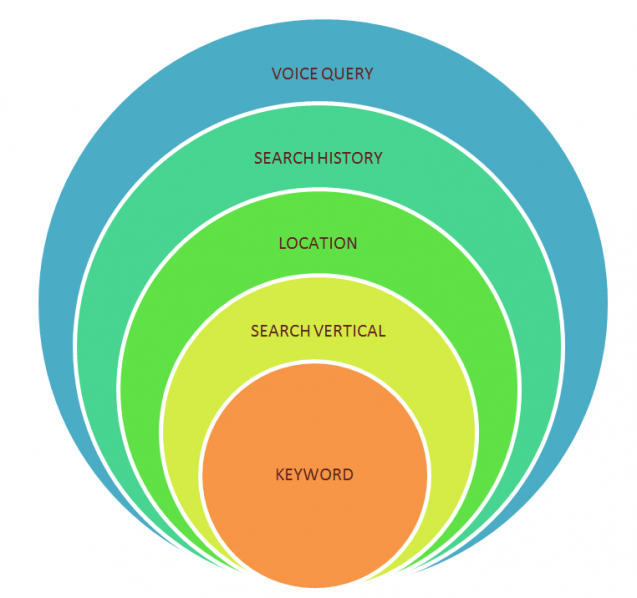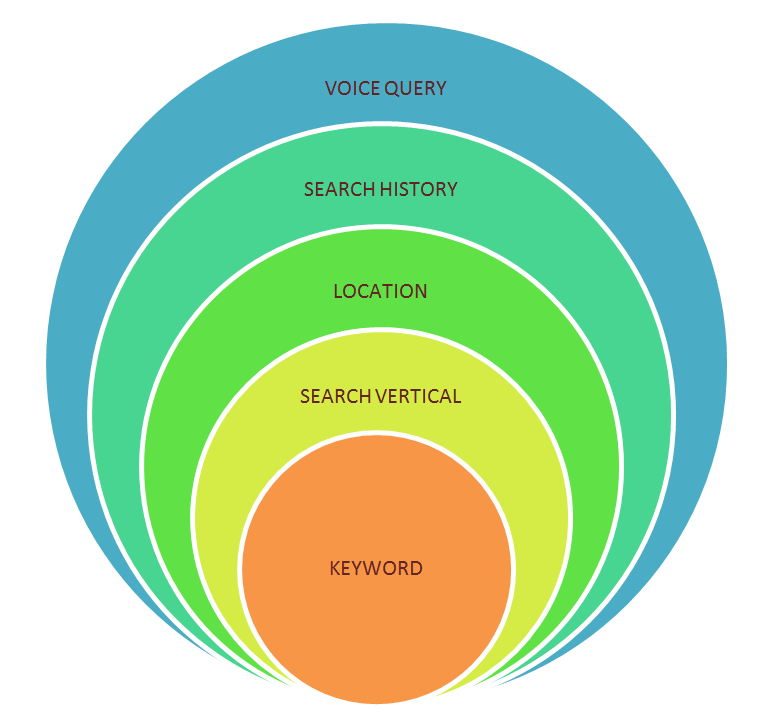Just for a moment, let us move away from how we, search optimizers, view search and look at it through the eyes of people who build search engines, shall we?
Now, search engine developers usually strive to achieve 2 goals simultaneously: to understand the searcher intent and to provide the best possible answer to satisfy that intent. Hence, the equation has two parts:
SEARCHER INTENT UNDERSTOOD + SEARCH RESULTS PROVIDED = SUCCESS
I believe that we, SEOs, have traditionally focused mostly on the second summand in this equation, that is, the search results. When it comes to understanding the searcher intent, the farthest we’d normally go is learning what keywords people use.
As for search engines, they’ve been taking user intent far more seriously and have developed an entire system of searcher intent markers (such as one’s geolocation, browsing history, etc.) that helps them understand what the user actually wants to find.

Now, as search engines are moving towards perfection, segmentation of search results triggered by different combinations of searcher intent markers continues, and it’s becoming ever harder for Internet marketers to predict what types of SERPs their website will appear in.
For example, you could be thinking that your website that sells tickets to Shea Stadium events ranks #1 for “Shea”, while, in reality, you get that rank only because you search from New York. And, a person searching from Alabama may see a result about shea butter or SHEA (Society for Healthcare Epidemiology of America) instead of your site.
So, not taking the searcher intent into account in a web marketing campaign is akin to selling stuff at the town’s marketplace having no idea what else is being sold there, what prices your competitors have, etc.
And this is what I’m going to talk about in this post – I’m going to talk about how to avoid playing blind by learning what searcher intent identifiers could influence the SERPs Google returns to the user, and how to optimize your site in such a way that it hits the search results your potential clients see. Let’s start by discussing the oldest and the most popular searcher intent marker – the keyword.
The keyword
The keyword has been a universal searcher intent marker for years – and rightly so. However, it has long stopped to be the only identifier of the searcher intent.
The application
As far as choosing keywords for a Web marketing campaign is concerned, I normally distinguish between SEO-driven keyword research and user intent-driven keyword analysis.
Some time ago, Eugene did a solid post on SEO-driven keyword research, so I’m not going to dwell on that now.
As for analyzing keywords with the user intent in mind, the most important thing to do in this respect is to try to predict potential meanings behind a certain keyword. The best tool to use for this purpose is your brain.
You can also use a dictionary or type the word into the search box to see what results it triggers. For example, when I type “gourmet food”, I get a bunch of local results (gourmet food restaurants) and places to buy gourmet food. So, if you have a website dedicated to gourmet food recipes, “gourmet food” may not be your best bet.
This goes to say that, for example, if you’re selling electronics on your site, it makes sense to optimize it for more specific keywords such as “laptops”, “flat-screen TV”, etc. Besides, think what else people might intend to find on your site. Could they be looking for reviews, price comparisons or the best deal? If so, be the one to provide them with this information (and to optimize for respective keywords).
Alternatively, you can resort to such innovative pieces of technology as Zenya (check out this review by Miranda Miller), which is a keyword database that lets you sort search terms by keyword intent.
The output
As the result of a searcher intent-oriented keyword research, you should get a list of well-targeted keywords that are non-confusing and are divided into categories (branded/non-branded; short-tail/long-tail, etc.)
Search verticals
Another user intent identifier is the vertical within which the user performs a search. When Google began segmenting its search results, this added a new dimension to the coordinate system of search.
Eli Goodman believes that vertical search emerged as the answer to the problem of the search engines returning poor results and the searchers ever having to refine their queries to express their intent. Now, what are the takeaways SEOs can get from vertical search?
The application
Previously, I’ve written an all-embracing post on how verticalization of search has been changing our searching habits. These days, people expect to get particular types of search results for particular queries. For instance, if one searches for “Libya”, they’d expect to see some News, Images and maybe other kinds of Universal Search listings mixed together with “regular” ones.
Now, how does one use different search verticals to drive extra traffic to their site? The simplest test you can perform is to type your keywords into the search box and see if they trigger any Images, Videos or other types of Universal Search listings.
Then, if you’d like to rank for the same keywords in the same categories, optimize your content accordingly. For example, if your blog post is about apple tree grafting, use “apple tree grafting” in the title of the image or the video that goes with your post. It’s also easier to make YouTube videos rank in search (at least in my experience), so, you could create a YouTube channel for your business and upload your videos there as well.
The output
As the results, one should have a stance/strategy on how to use different search verticals (images, videos, press releases, etc.) to maximize traffic and do it in such a way as to attract visitors with the right searcher intent.
Location
Local search is real big these days (or should I say huge?). When search engines began tailoring their search results to the user’s geolocation, relevance of the latter increased manifold.
Hence, we have another important searcher intent marker – the user’s location. Who should pay attention to this identifier when running a Web marketing campaign? Any local business or services provider should, which is the predominant share of walk-in businesses.
The application
To reach the user who performs a local search, one has to show up in local search results. There are numerous articles on how to get there. One thing to remember – you don’t show up there only because you have a website. You need to be listed on Google+ Local (new Google’s alternative to Google Places), in local directories, and have good/enough ratings and mentions to appear near the top.
Besides, try to improve user experience by sparing your visitors the need to confirm or set their location when they visit your site. For example, if you have separate pages for your Italian, Singaporean or other visitors, better send them to the right version without asking. Or surprise them even more by guessing what time of day it is by them and providing the type of content they might be looking for in that hour.
The output
Eventually, your biz should be visible to the searcher when the latter searches from a specific location, and provide the experience tailored to that particular user’s whereabouts.
[Search History]
It’s no secret that these days search engines custom-tailor search results based on what people previously searched for and what results they clicked on. But there is barely any point to try to take this searcher intent marker into account in an online marketing campaign, as browsing history varies from person to person, and it is impossible to imitate the average search history of your target group.
Voice search
Now, a real change to searcher intent markers came with voice search. As you probably know, voice recognition technologies existed for a while, but it wasn’t until Siri that the SEO industry began taking voice search seriously.
With voice search, the searcher doesn’t type keywords into the search box, but talks to the search engine as if it were a person. In commenting on Siri, Google’s executive chairman, Eric Schmidt, called it “a direct challenge to Google’s search engine”. Why? Because it really is a game changer.
Nowadays, however, Google has come up with a voice search app for iOS that’s barely inferior to Siri. I’m sure you’ll find a gazillion of Siri vs. Google voice search reviews, but, in my observation, Google’s app is better at search (and faster), while Siri is better in assisting you with other things such as making phone calls, scheduling meetings, etc.
The application
Now, the real challenge is to be the best answer to the searcher’s spoken question. How do the search engines know what the user means? What intent markers do they take into account?
Google says (and, please, remember that the lion share (60%) of Siri-provided results is powered by Google as well) that it looks at one’s previous searchers and location when providing voice search results.
There is also a presentation by Matt Siltala saying that by getting a Yelp premium subscription, one increases their rankings in Siri’s search results. This is probably because nearly 50% of all mobile searches are said to be local in nature, and Yelp has been estimated to power over 50% of all Siri’s local results.
Well, I’m not planning to pitch for a paid Yelp membership (as I consider Yelp a controversial review platform), but improving your Yelp ratings also helps your local search ratings, which means you can sort of kill 2 birds with one stone.
Another point that’s important to make in regards to voice search is that it’s mobile-based, and a mobile site/listing would naturally stand a better chance of getting ranked higher in the search results.
And, as far as keyword research for Siri/Google’s voice search is concerned, as Cindy Krum said in an article, “voice search… appears to simply translate a voice query then submit it thorough the same mobile search algorithms as if it was typed in.”
The output
In the end, to be prepared to tap into voice search, one should have an aggregate mobile, local and social strategy for their business.
Conclusion
I expect that, in the future, the number of searcher intent identifiers will become bigger. Besides, those intent markers that exist nowadays will have different impact. For example, they say that the number of voice-powered queries is now increasing. I personally think that voice search, local+social+mobile and vertical search will own the future, but the time to start takings searcher intent seriously is now.




